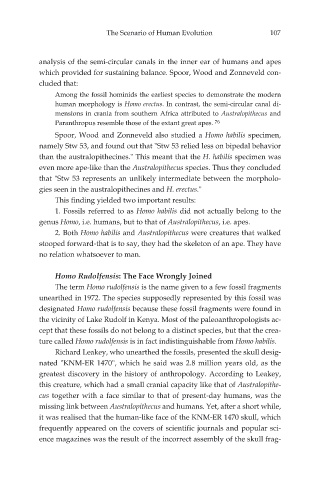Page 109 - The Evolution Deceit
P. 109
The Sce nar io of Hu man Ev o lu tion 107
analysis of the semi-circular canals in the inner ear of humans and apes
which provided for sustaining balance. Spoor, Wood and Zonneveld con-
cluded that:
Among the fossil hominids the earliest species to demonstrate the modern
human morphology is Homo erectus. In contrast, the semi-circular canal di-
mensions in crania from southern Africa attributed to Australopithecus and
Paranthropus resemble those of the extant great apes. 76
Spoor, Wood and Zonneveld also studied a Homo habilis specimen,
namely Stw 53, and found out that "Stw 53 relied less on bipedal behavior
than the australopithecines." This meant that the H. habilis specimen was
even more ape-like than the Australopithecus species. Thus they concluded
that "Stw 53 represents an unlikely intermediate between the morpholo-
gies seen in the australopithecines and H. erectus."
This finding yielded two important results:
1. Fossils referred to as Homo habilis did not actually belong to the
genus Homo, i.e. humans, but to that of Australopithecus, i.e. apes.
2. Both Homo habilis and Australopithecus were creatures that walked
stooped forward-that is to say, they had the skeleton of an ape. They have
no relation whatsoever to man.
Homo Rudolfensis: The Face Wrongly Joined
The term Homo rudolfensis is the name given to a few fossil fragments
unearthed in 1972. The species supposedly represented by this fossil was
designated Homo rudolfensis because these fossil fragments were found in
the vicinity of Lake Rudolf in Kenya. Most of the paleoanthropologists ac-
cept that these fossils do not belong to a distinct species, but that the crea-
ture called Homo rudolfensis is in fact indistinguishable from Homo habilis.
Richard Leakey, who unearthed the fossils, presented the skull desig-
nated "KNM-ER 1470", which he said was 2.8 million years old, as the
greatest discovery in the history of anthropology. According to Leakey,
this creature, which had a small cranial capacity like that of Australopithe-
cus together with a face similar to that of present-day humans, was the
missing link between Australopithecus and humans. Yet, after a short while,
it was realised that the human-like face of the KNM-ER 1470 skull, which
frequently appeared on the covers of scientific journals and popular sci-
ence magazines was the result of the incorrect assembly of the skull frag-

